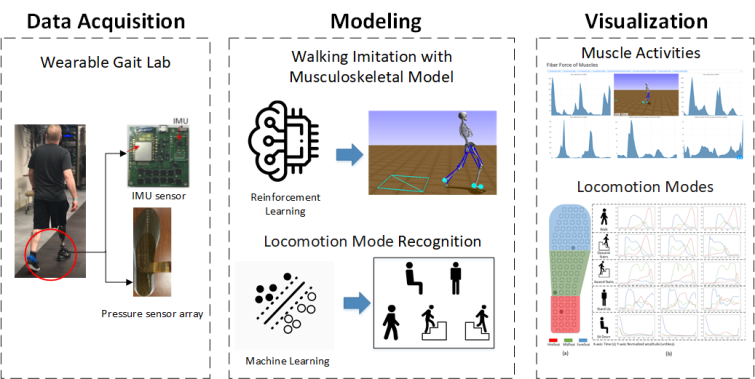Internet of Wearable Things - Wearable Nanofabrication Designs Create Better Fitting Intelligent Prosthetic Sockets (PI: Dr. Ming-Chun Huang, Co-PI: Dr. Hongping Zhao at Ohio State University, and Clinical Collaborator: Dr. Rahila Ansari from VAMC)
The past decades have witnessed great progress in the prosthetics field through new materials and technologies such as targeted muscle reinnervation, powered knee, and ankle prosthesis. However, the biomechanical load due to the unnatural mechanical interaction between the soft tissues of the residual limb and the prosthetic socket is still not fully understood and needs to be further investigated. A poorly-fitting socket can lead to chronic skin problems, including pressure ulcers, dermatitis, infections, and pain, which seriously affect a patient’s health and quality of life. However, making a socket that fits well over the long term is a complicated and challenging process. Currently, a liner is used to provide a vacuum seal and cushioning materials. Although the liner can help prolong the comfort associated with the socket, the liner does not monitor the occurrence of chronic skin problems associated with a poorly fitting socket.
This interdisciplinary research project created new sensing and computational methods enabling knowledge discovery for a better prosthesis fitting quality with the goal of enhancing the design, fit, usability, and interface of prosthetic limbs for individuals with amputation in practice. This EArly-concept Grant for Exploratory Research (EAGER) project supported exploratory work on material simulation and synthesis, which is designing and fabricating ZnO 3D nanowall network-based sensor devices on a flexible platform. The overall research project consisted of sensor material synthesis, device fabrication, platform, and signal processing unit design for the stump-socket interface application to analyze the information that affects the sense of comfortable fit.
This multidisciplinary research brought together the fields of digital design and test, human-machine interface, sensors, and signal processing and extending the impact of mobile sensing and health technology to prosthetics research. A team of investigators and students from Case Western Reserve University and the Cleveland Veterans Affairs Medical Center with complementary expertise successfully carried out this collaborative project.
This project has supported 2 Ph.D. students. Completed research results were published in IEEE Sensors, IEEE IoT, and ACS (chemicals/materials) Journals and have been presented in the 2018 IEEE Biomedical Circuits and Systems Conference. This research was reported by NSF Computer Systems Research (CSR) Newsletter as one of the CSR Spotlight Projects, July 2019 and Veterans Affairs & Military Medicine Magazine Outlook, ”Wearable Technology - On the Threshold of Clinical Care”, Fall 2018.
Publications: 3 journal papers and 1 conference paper [J30, J21, J18, C26].




